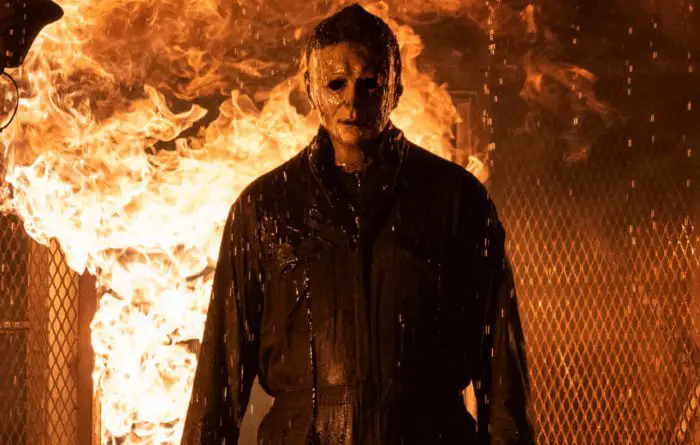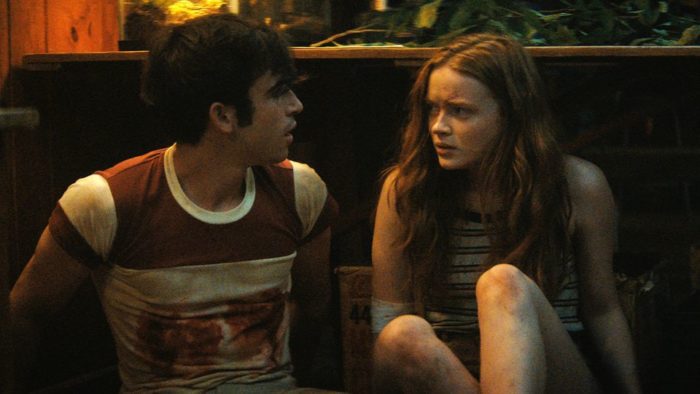As 2021 winds to a close, it’s time to take stock of what we’ve gained over the past year, as well as think about the future and what we have to look forward to. This year, fans of the slasher genre were fortunate enough to get three excellent—well, two excellent and one highly debatable—films that feel like the beginning of an evolution of the genre: Candyman, Halloween Kills, and the Fear Street trilogy. So as we take stock of the year now behind us let’s look back on each of those films and see how they point towards a bigger, bolder, and bloodier future for the genre.
Candyman: Social Commentary and Slashings Go Hand-In-Hook
Candyman, released just about midway through 2021, serves as not just a reimagining of its titular villain, but a rebirth in every sense of the word. Not only is the character of Candyman himself reborn into the new physical form of Anthony McCoy, but the very idea of what he is and what he represents is also transformed in a fundamental way. No longer is he simply the vengeful spirit of Daniel Robitaille, he’s a collective of an untold number of victims of systemic racial violence and a symbol of injustice—and eventually, of rising up against said injustice.
Everything about Candyman feels vital to not just the story of Anthony McCoy but to the wider narrative that DaCosta sets out to tell of gentrification and the racial injustice that the Black faces community again and again, with moments often having layers upon layers of meaning that practically demand rewatching. The level of detail in Candyman is downright insane at times. Two prominent examples are when the art critic gets murdered and the first streak of her blood on the window is practically identical to the first brushstroke of Anthony’s newest project and the fact that the full name Anthony McCoy is said exactly five times throughout the film, with the fifth time being the moment he becomes Candyman.
But Anthony’s rebirth as part of the Candyman “hive” isn’t just a way of tying the events back to the original film while simultaneously widening its scope. It also serves as a wider commentary on a wider, grimmer truth: that America is not a place where Black people and people of color can ever truly be safe, no matter how accomplished they might become. Anthony and his partner Brianna are people who should have a fair amount of safety and comfort in their lives, living in the now gentrified and “safe” neighborhood where the Cabrini-Green projects once stood and having fairly successful careers in the art community. Yet, by the end of the film, they both find themselves in situations we see all too often: one shot dead by police and the other in the back of a squad car, being threatened by an officer to corroborate their version of events.
At least until Brianna says his name five times while looking in the rearview mirror, summoning the new Candyman to inflict bloody vengeance on the perpetrators of racial injustice. Notably, Brianna is the second person of color following Anthony who dares to summon the Candyman, and the first appearance of the Anthony McCoy Candyman marks the transformation that Burke—Anthony’s source on the Candyman legend—was seeking: from a symbol of racial injustice to a symbol of fighting back against said injustice.

Candyman’s new appearance, now confined to mirrors and reflective surfaces with his face hidden in shadows from everyone except Anthony, feels like a reflection (pun intended) of about three different elements—while also presenting some of the most frightening horror imagery of the year. It reflects the gentrification of Cabrini-Green that has buried not just the Candyman legend but also the lives of any number of people who lived there; how the Candyman legend isn’t just about the story of Daniel Robitaille but of countless men of color who were the victims of racial injustice and brutality to the point; and how the lives of people of color and the violence they often face often seem invisible to people who only see value in what can be gained from them, whether that’s Laura Ingraham telling Lebron James to “shut up and dribble” when he spoke up about racial injustice or Burke telling Anthony that “they love what we make, but not us.”
There’s even subtext on the tension found in representations of Black trauma in art: how Black artistic expression often seems to only reach acclaim when it is tied to stories and imagery of Black trauma—but only a sanitized, “safe” version of said trauma. As the film goes on, we watch as Anthony’s paintings grow closer to truth and further away from sanitized, easy-to-process symbolism before it finally reaches the truest expression of said trauma: the feverishly drawn portraits of the men—and one boy—who were victims of racial injustice and violence that became part of the Candyman legend.
Slasher films have always had some level of social commentary—The Texas Chain Saw Massacre was an allegory for the Vietnam War and the chaotic sense of late ‘60s/early ‘70s America, and Halloween has been analyzed as everything from a tale of the violent endgame of the worst parts of toxic masculinity to one of judgment being passed on teenagers who abdicate their responsibilities. But there’s never been a slasher film—at least none that I’ve ever seen—with such a deep message to tell, or as meticulously crafted to have just about every detail serve to help tell that narrative, while still being one of the scariest films of the year. Even everything I’ve talked about here feels like I’ve only scratched the surface of meaning in Candyman, and it feels like a new step forward for the genre, one where the social commentary and the slashings truly go hand in hand—or, hand in hook, if you will.
Halloween Kills: A Monster Tearing at the Bars of Its Cage
On the other side of the spectrum, we have Halloween Kills, a film that is…not as universally beloved as Candyman—and has even been the subject of a fair amount of debate amongst my coworkers and me.
Halloween Kills is nowhere near as deep of a film as Candyman is in terms of narrative or wider social commentary. There is certainly some present, mostly to do with disinformation, mass panic, and mob violence, but it’s not as central to the narrative as it is to Candyman. Instead, where Halloween Kills pushes the genre forward is how relentlessly intense it is and how it feels like a slasher film that is pushing at the boundaries and the structure of the genre itself.
Halloween Kills reaches a level of brutality that I don’t think I’ve ever seen in a slasher film before. For reference, the original Halloween—often considered the blueprint for the slasher film—had a grand total in the ballpark of five kills, while Halloween Kills has just shy of thirty. It’s a kill count closer to a Schwarzenegger film than a typical slasher.
And oh, what kills they are. Halloween Kills is an uncompromisingly violent film. Characters are introduced and killed off in a matter of minutes. Michael absolutely tears through anyone unfortunate enough to cross his path with knives and glass and anything he can get his hands on—and barring that, with his bare hands. One unfortunate victim gets a broken halogen lamp shoved through her throat, and the most memorable kill of the film sees a woman firing a particularly large pistol at Michael, only for him to kick open a car door at precisely the right time she pulls the trigger, causing her to accidentally blow her own head off.

But his victims aren’t just killed and left behind—each scene of carnage finds said victims arranged into what can only be described as a series of deranged art projects, offering a glimpse into an alternate reality where Michael becomes the only thing worse than a serial killer with a double-digit body count: an art major and perhaps a kindred spirit of our dear friend Candyman, given at least two of the bees buzzing around in the hive—Daniel Robitaille and Anthony McCoy—are artists-turned-hook-handed-serial-killers. One corpse has kitchen knife after kitchen knife plunged into it until Michael finds one that he’s satisfied with, another group of victims is arranged on a playground donning masks resembling the ones used by Silver Shamrock in Halloween III, and another couple is almost tenderly arranged to match a photograph of the two from happier times resting on a mantle behind them.
But even when Michael isn’t on screen, his presence is felt everywhere. Not a single moment in Halloween Kills feels safe. One of our writers wrote a piece a while back about how the Halloween series was a uniquely primal horror series, and Kills takes this sense and dials it up to eleven. There’s hardly a single moment of screen time that isn’t filled with some combination of grief, terror, loss, regret, and rage. The “Babysitter Murders,” as they’re known in-universe, are a wound on the town of Haddonfield that has never fully closed, and Michael’s reappearance after 40 years rips it right back open and brings out the worst in those old enough to remember Halloween of 1978.
Halloween Kills doesn’t set out to do anything particularly new or deep in terms of its content but instead aims to push the structure of the slasher to its breaking point. It’s based on a very simple principle: sometimes, you don’t need to reinvent the wheel. The wheel is good. The wheel has stood the test of time. If you try to reinvent the wheel, you usually get a misshapen mess that can’t effectively get you anywhere. But even though you might be sticking with the wheel, you can absolutely rev said wheel to see how fast it can go, turning it into a white-hot, screeching, lethal weapon. I expect to see slashers a few years from now dialing into this same level of intensity to try and match or even beat Halloween Kills—and I can’t wait to see how future slashers turn out if they try and go down this route.
Fear Street: The First of Its Kind?
Originally, this piece was only meant to be about Candyman and Halloween Kills, but after a recent rewatch of the Fear Street trilogy that hit Netflix in July of this year, I realized that these films were pushing the slasher film forward in their own way. I’ve already written somewhat extensively on the Fear Street trilogy, so here I’ll focus mostly on the steps forward it takes for the slasher genre.
Fear Street is somewhere in the middle ground between Candyman and Halloween Kills. It’s not wrapped around its deeper narrative to the same level as Candyman, nor does it push the limits of the structure as much as Halloween Kills. But it does carry elements of each film’s distinct approach and winds up feeling like something new, hidden beneath its initial nostalgic facade.
Structurally, the Fear Street movies feature a novel approach that takes advantage of being in the streaming age, taking three movies and showing one per week, in reverse chronological order. Sequels and franchises are nothing new to the slasher genre, but by taking this approach, the trilogy takes what might have otherwise been a one-and-done film and makes it into a month-long summer event.

Each film tells its own complete story and has its own distinct tone, but they all fit into the larger narrative, adding bits and pieces to the lore and providing new context on things we’ve already seen. It’s almost like a triptych, with one new panel being revealed each week, inviting you to discuss and rethink the previous panels with the new information you’re given.
As for that larger narrative and social commentary, while it’s not as pervasive as it was in Candyman it’s no less essential or impactful as it was in that film. Once we reach the big twist at the end of 1666, the story reveals itself to be one about how LGBTQIA+ people are treated as deviants and wind up being blamed for societal failings. The story shows us how patriarchal power structures are upheld largely through their own mythmaking and ability to control the narratives surrounding people’s lives.
While this social commentary doesn’t make itself explicitly known until the third act, it’s so impactful that it makes you reexamine the other two films with this subtext in mind. Our view of both characters and entire communities shift in a context in light of what we discover, and we find that almost nothing has been what we think it was while the film takes a sledgehammer to the lore they’ve built up over the previous two films.
It’s a brilliant way to end the trilogy, and one of the more nuanced stories told in a slasher film in recent memory.
In short, 2021 has been a huge gift to fans of the slasher genre, and hopefully a signpost to where the genre is going in the future. Whether it’s Candyman pushing the depth of the genre’s content, Halloween Kills pushing the limits of its structure, or the Fear Street trilogy taking bits from each approach, if this year is any indication of where the genre is heading, we’ll have plenty of exquisite slasher films to look forward to in the years to come.



